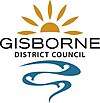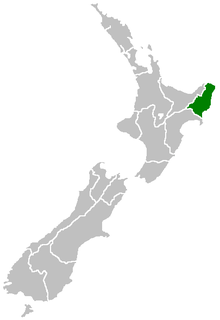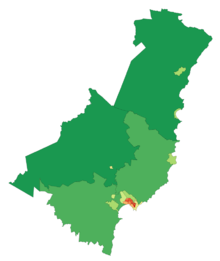Gisborne District
The Gisborne District (Māori: Te Tairāwhiti or Te Tai Rāwhiti) is an area of northeastern New Zealand governed by the Gisborne District Council. A unitary authority (with the combined powers of a district and regional council), it is also known as the Gisborne Region.[3] It is named after its largest settlement, the city of Gisborne. The region is also commonly referred to as the East Coast.[4]
Gisborne District Te Tairāwhiti | |
|---|---|
 | |
 | |
| Country | |
| Region | Gisborne Region |
| Territorial authority | Gisborne District Council |
| Seat | Gisborne City |
| Government | |
| • Mayor | Rehette Stoltz |
| • Deputy Mayor | Josh Wharehinga |
| Area | |
| • Territorial | 8,355 km2 (3,226 sq mi) |
| Population (June 2019)[1] | |
| • Territorial | 49,300 |
| • Density | 5.9/km2 (15/sq mi) |
| • Urban | 35,500 |
| Area code(s) | 06 |
| HDI (2017) | 0.872[2] very high · 16th |
| Website | GDC.govt.nz |
The region is commonly divided into the East Cape and Poverty Bay. It is bounded by mountain ranges to the west, rugged country to the south, and faces east onto the Pacific Ocean.
Name and history
Prior to the late 19th century, the area was known as Tūranga. However, as the Gisborne town site was laid out in 1870, the name changed to Gisborne, after the Colonial Secretary William Gisborne, and to avoid confusion with the town of Tauranga.[5]
The region was formerly known as the East Coast, although the region is often divided into the East Coast proper (or East Cape), north of the city, and Poverty Bay, the area including and surrounding the city. The region is also sometimes referred to as the East Cape, although that also refers specifically to the promontory at the northeastern extremity. More recently, it has been called Eastland, although that can also include Ōpōtiki in the eastern Bay of Plenty to the northwest, and Wairoa to the south.[4]
Its Māori name Te Tai Rāwhiti means the Coast of the Sunrise,[6] reflecting the fact that it is the first part of the New Zealand mainland to see the sun rise. Gisborne District Council styles the name as Te Tairāwhiti.
Geography
The region is located in the northeastern corner of the North Island. It ranges from the Wharerata Hills in the south, which divide it from the Wairoa district in the Hawke's Bay region, to Lottin Point in the north. The western boundary runs along the Raukumara Range, which separates it from the Opotiki district. In the southwest, its boundary runs along the western edge of Te Urewera National Park.
It is sparsely inhabited and isolated, with small settlements mainly clinging to small bays along the eastern shore including Tokomaru Bay and Tolaga Bay. Its population is 49,300 (June 2019).[1] Three-quarters of the population – 35,500 (June 2019)[1] – lives in the city of Gisborne. No other settlement has a population of over 1000. The largest other settlements are the towns of Tolaga Bay and Ruatoria, each with populations of over 800 in 2001.
Inland, the land is rough, predominantly forested, hill country. A spine of rough ridges dominates the centre of the region, culminating in the impressive bulk of the 1752 metre Mount Hikurangi in Waiapu Valley in the region's northeast. This mountain is the fifth highest mountain in the North Island, and the highest that is not a volcano. Regarded as sacred by the Māori, there is some justification to the claims that this is the first mountain to see the sun in summer.
The region's population has higher than the national average proportion of Māori - over 50% in some areas - and still maintains strong ties to both Māori tradition and the iwi and marae structure. The predominant iwi are Ngāti Porou, Rongowhakaata, Ngai Tamanuhiri, Te Aitanga a Mahaki.
Government
Gisborne District Council is a unitary territorial authority, which means that it performs the functions of a regional council as well as those of a territorial authority (a district or city). It includes a mayor, 13 elected councillors,[7] an appointed chief executive officer, 4 department managers and approximately 250 staff. The district council and main administration centre is located in Fitzherbert Street, in the city of Gisborne.[8] The area it governs is constituted as both the Gisborne District and the Gisborne Region.[3]
Gisborne District Council was created as part of a major nationwide reform of local government in 1989. It replaced the councils of Gisborne City, Cook County, Waiapu County and Waikohu County, East Cape United Council, East Cape Catchment Board and Regional Water Board, East Coast Pest Destruction Board, two harbour boards, and several noxious plants authorities and recreation reserve boards.[3] It was the only unitary authority in New Zealand until three others were created in 1992.
Economy
The subnational gross domestic product (GDP) of the Gisborne region was estimated at NZ$2.16 billion in the year to March 2019, 0.7% of New Zealand's national GDP. The regional GDP per capita was estimated at $44,004 in the same period.[9]
Climate
The region is sheltered by high country to the west and has a dry, sunny climate. It has a yearly average of 2,200 sunshine hours. The annual rainfall varies from about 1000mm near the coast to over 2500mm in higher inland country. Typical maxima range from 20-28 °C in summer and 10-16 °C in winter. Minima vary from 10-16 °C in summer to 0-8 °C in winter.
| Climate data for Gisborne | |||||||||||||
|---|---|---|---|---|---|---|---|---|---|---|---|---|---|
| Month | Jan | Feb | Mar | Apr | May | Jun | Jul | Aug | Sep | Oct | Nov | Dec | Year |
| Average high °C (°F) | 24.9 (76.8) |
24.2 (75.6) |
22.6 (72.7) |
19.9 (67.8) |
17.1 (62.8) |
14.7 (58.5) |
14.1 (57.4) |
14.9 (58.8) |
16.8 (62.2) |
19.0 (66.2) |
21.3 (70.3) |
23.3 (73.9) |
19.5 (67.1) |
| Average low °C (°F) | 13.6 (56.5) |
13.6 (56.5) |
12.2 (54.0) |
9.6 (49.3) |
6.9 (44.4) |
5.3 (41.5) |
4.6 (40.3) |
5.4 (41.7) |
6.8 (44.2) |
8.6 (47.5) |
10.5 (50.9) |
12.3 (54.1) |
9.1 (48.4) |
| Average precipitation mm (inches) | 54 (2.1) |
78 (3.1) |
99 (3.9) |
103 (4.1) |
97 (3.8) |
125 (4.9) |
119 (4.7) |
93 (3.7) |
101 (4.0) |
63 (2.5) |
65 (2.6) |
67 (2.6) |
1,050 (41.3) |
| Source: NIWA Climate Data[10] | |||||||||||||
Demographics
| Year | Pop. | ±% p.a. |
|---|---|---|
| 1986 | 45,768 | — |
| 1991 | 44,361 | −0.62% |
| 1996 | 45,962 | +0.71% |
| 2001 | 43,971 | −0.88% |
| 2006 | 44,499 | +0.24% |
| 2013 | 43,653 | −0.27% |
| 2018 | 47,517 | +1.71% |
| Source: [11][12][13] | ||
Gisborne Region had a population of 47,517 at the 2018 New Zealand census, an increase of 3,864 people (8.9%) since the 2013 census, and an increase of 3,018 people (6.8%) since the 2006 census. There were 16,410 households. There were 23,394 males and 24,126 females, giving a sex ratio of 0.97 males per female. Of the total population, 11,283 people (23.7%) were aged up to 15 years, 8,766 (18.4%) were 15 to 29, 20,124 (42.4%) were 30 to 64, and 7,344 (15.5%) were 65 or older. Figures may not add up to the total due to rounding.
Ethnicities were 58.1% European/Pākehā, 52.9% Māori, 4.5% Pacific peoples, 2.8% Asian, and 1.4% other ethnicities. People may identify with more than one ethnicity.
The percentage of people born overseas was 9.7, compared with 27.1% nationally.
Although some people objected to giving their religion, 48.2% had no religion, 36.4% were Christian, and 7.1% had other religions.
Of those at least 15 years old, 5,382 (14.9%) people had a bachelor or higher degree, and 7,944 (21.9%) people had no formal qualifications. The median income was $25,900. The employment status of those at least 15 was that 17,064 (47.1%) people were employed full-time, 5,451 (15.0%) were part-time, and 1,872 (5.2%) were unemployed.[13]
In the 2013 census, 73.0% of the population could speak in one language only, 16.2% in two languages and 1.1% in three or more languages.[11]
Urban areas
Gisborne, with a population of 35,500,[1] is the only urban area in the district with a population over 1,000. It is home to 72.0% of the district's population.
Other towns and settlements in the Gisborne district include:
2007 earthquake

At 8.55pm (NZDT) on 20 December 2007, the Gisborne region was hit by an earthquake of Richter magnitude 6.8, centred in the Hikurangi Trench which is a part of the Hikurangi Margin. The earthquake was situated 50 km southeast of Gisborne at a depth of 40 km.[14] Mercalli intensities of 7-8 were experienced, with three buildings substantially collapsed in the CBD and others experiencing some structural damage. One death was reported (a heart attack of an elderly woman, sustained during the quake) plus minor injuries.[15]
Sport
The region is represented in rugby union by the East Coast Rugby Football Union and the Poverty Bay Rugby Football Union.
See also
- 2006 Tonga earthquake
- List of marae in the Gisborne District
- List of people from Gisborne
- List of schools in the Gisborne District
References
- "Subnational Population Estimates: At 30 June 2019". Statistics New Zealand. 22 October 2019. Retrieved 11 January 2020.
- "Sub-national HDI - Area Database - Global Data Lab". hdi.globaldatalab.org. Retrieved 13 September 2018.
- "The Local Government (Gisborne Region) Reorganisation Order 1989" (PDF). New Zealand Gazette. 9 June 1989. pp. 2328 ff. Retrieved 5 June 2014.
- Soutar, Monty (13 July 2012). "East Coast region – Overview". Te Ara – the Encyclopedia of New Zealand. Retrieved 31 May 2014.
- Soutar, Monty. "East Coast places". Te Ara Encyclopedia of New Zealand. New Zealand Ministry for Culture and Heritage Te Manatu. Retrieved 31 October 2018.
- Cowan, James (1926). The Māoris in the Great War. pp. 179–80. Retrieved 7 June 2014.
- "Local Government Commission : Determination of representation arrangements to apply for the election of the Gisborne District Council to be held on 12 October 2013" (PDF). Lgc.govt.nz. Retrieved 7 April 2018.
- "Gisborne District Council » Contact us". Gisborne District Council. Retrieved 31 October 2018.
- "Regional gross domestic product: Year ended March 2019 | Stats NZ". www.stats.govt.nz. Retrieved 21 May 2020.
- "Climate Data". NIWA. Retrieved 25 February 2009.
- "2013 Census tables about a place: Gisborne District". Statistics New Zealand. Retrieved 1 February 2016.
- "1996 Census of Population and Dwellings – Census Night Population". Statistics New Zealand. 28 February 1997. Archived from the original on 13 February 2016. Retrieved 1 February 2016.
- "Statistical area 1 dataset for 2018 Census". Statistics New Zealand. March 2020. Gisborne Region (05). 2018 Census place summary: Gisborne Region
- "GeoNet – New Zealand Earthquake Report". Geonet.org. 20 December 2007. Archived from the original on 22 December 2007. Retrieved 7 April 2018.
- Binning, Elizabeth (21 December 2007). "Quake damage extensive as massive clean-up begins". The New Zealand Herald. NZPA. Retrieved 1 October 2011.
External links
| Wikivoyage has a travel guide for East Coast (New Zealand). |
| Wikimedia Commons has media related to Gisborne District. |